So, you believe you have a picky cat? As someone deeply involved in the world of feline content creation at solcat.net and having spent years caring for cats, I can tell you, you’re not alone! Many cat parents reach out seeking advice on navigating the sometimes baffling eating habits of their beloved companions. Every cat is unique, and that extends to their culinary preferences. This guide is designed to be your go-to resource, offering a range of strategies to understand and work with your “Foodie Cat,” one tip at a time. Feel free to explore, experiment, and revisit as needed. And if you have more questions, don’t hesitate to reach out through our contact page!
We’re also developing a companion piece that delves into the scientific reasons behind these feeding methods, which we’ll link here soon.
Are Cats Truly Picky Eaters, or Discerning Foodies?
While domesticated, cats retain strong instincts, particularly concerning survival. Their core programming revolves around avoiding danger, including the danger of consuming unsafe food. This innate caution is deeply tied to their evolutionary need to “eat and find food” without risking poisoning.
But if their drive is to “eat and find food,” why do we perceive cats as “picky”?
The answer lies partly in a crucial developmental phase. Kittens experience a critical window between 2 and 8 weeks of age. During this period, they are incredibly receptive to new experiences, especially concerning food. Around 10 weeks, as teething begins, their exploration of solid foods intensifies. Exposure to diverse foods during this window shapes their perception of what is “edible.” However, once this sensitive period closes, cats become more cautious about unfamiliar foods.
Think about it from a human perspective: imagine being presented with a cuisine entirely foreign to you. The menu is in an unfamiliar language, listing ingredients you’ve never encountered. Unless you’re a particularly adventurous foodie, you’d likely approach this meal with hesitation, perhaps even reluctance. You lack information about its safety and palatability.
Cats experience similar reservations towards foods they haven’t been exposed to during their critical kittenhood phase. They instinctively assess unfamiliar food for potential danger. Introducing new foods, therefore, often requires patience and a strategic approach to convince your feline friend that it’s safe and palatable.
The Short Paw Point:
Cats learn what constitutes food early in life. After this learning window, they exhibit natural caution towards new foods. Some cats are more adventurous than others, but this caution is rooted in instinct, not mere pickiness. Understanding this is key to working with your “foodie cat.”
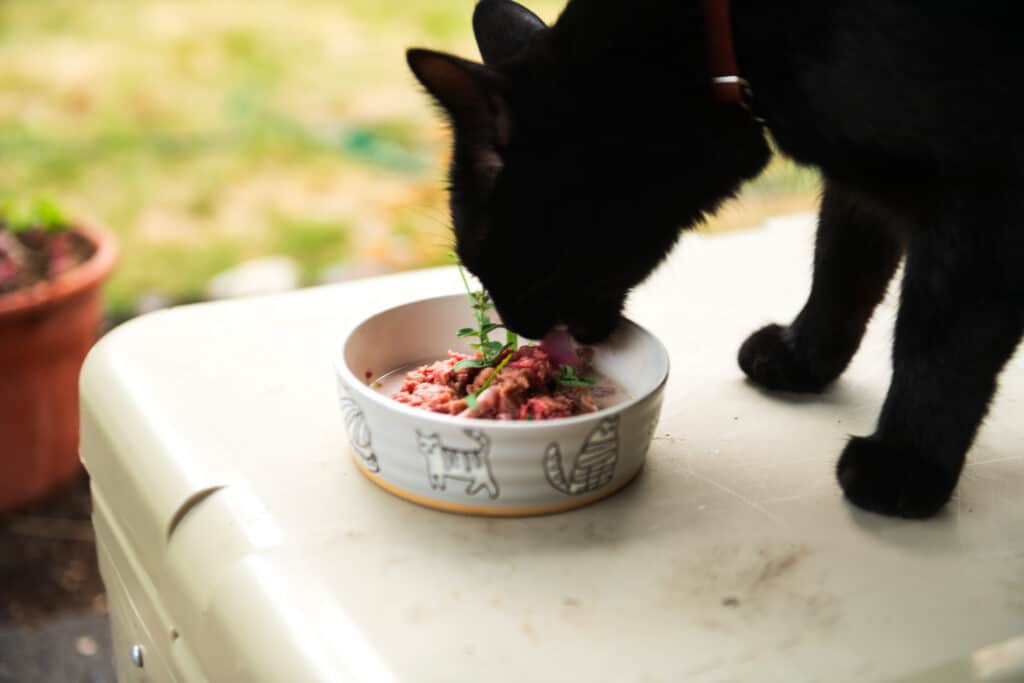 Cat eating his raw food
Cat eating his raw food
Decoding the “Foodie Cat”: Why Your Cat Might Seem Disinterested in Meals
Now that we understand that feline “pickiness” is often caution, you might still wonder, “Why does my cat reject food they normally eat?”. Let’s explore some common reasons why your foodie cat might be turning up their nose at mealtime.
Reason 1: Mealtime Boredom
Believe it or not, boredom can play a significant role in a cat’s eating habits. Imagine eating your absolute favorite dish every single day, for every meal. Initially, it might be a dream come true. However, after a while, even the most beloved food can become monotonous and unappetizing.
You might be thinking, “Okay, but how do I offer variety when my cat already refuses anything new?” Don’t worry, we’ll address introducing new foods later in this guide (jump to the “Introducing New Foods” section). For now, let’s consider how routine can lead to mealtime ennui for your foodie cat.
Reason 2: Overly Easy Access to Food
Kibble, or dry cat food, is incredibly convenient for pet owners. It can be left out all day without spoiling, allowing cats to graze whenever they please. While convenient, this free-feeding approach can inadvertently contribute to a cat’s disinterest in scheduled meals.
Think of it this way: if you had snacks constantly available, you might not be very enthusiastic when dinner is served. You’ve already nibbled throughout the day and know you won’t go hungry if you skip a formal meal.
If you primarily feed kibble and supplement with wet food, consider transitioning away from free-feeding kibble. Interactive food puzzles are excellent alternatives. They require cats to work a bit for their kibble, making mealtime more engaging and less about passive grazing. Puzzle feeders also help portion control, ensuring your cat is genuinely hungry for their wet food meals.
(If nighttime food requests are an issue, check out this helpful post on stopping your cat from waking you up for food).
Featured Product:
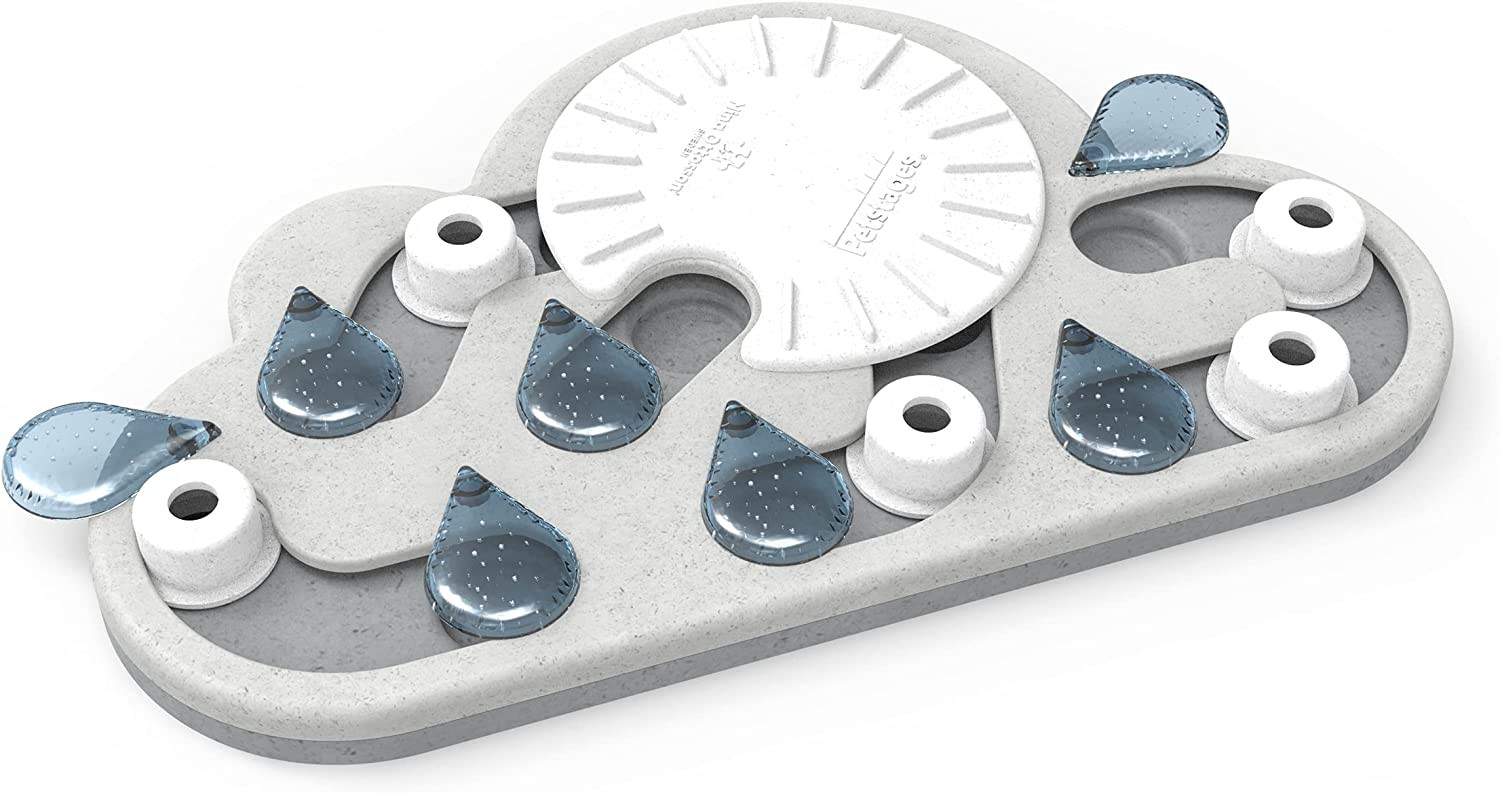
Highly Recommended!
Petstages Rainy Day Interactive Cat Puzzle
This puzzle engages your cat’s hunting instincts and keeps them entertained during mealtime.
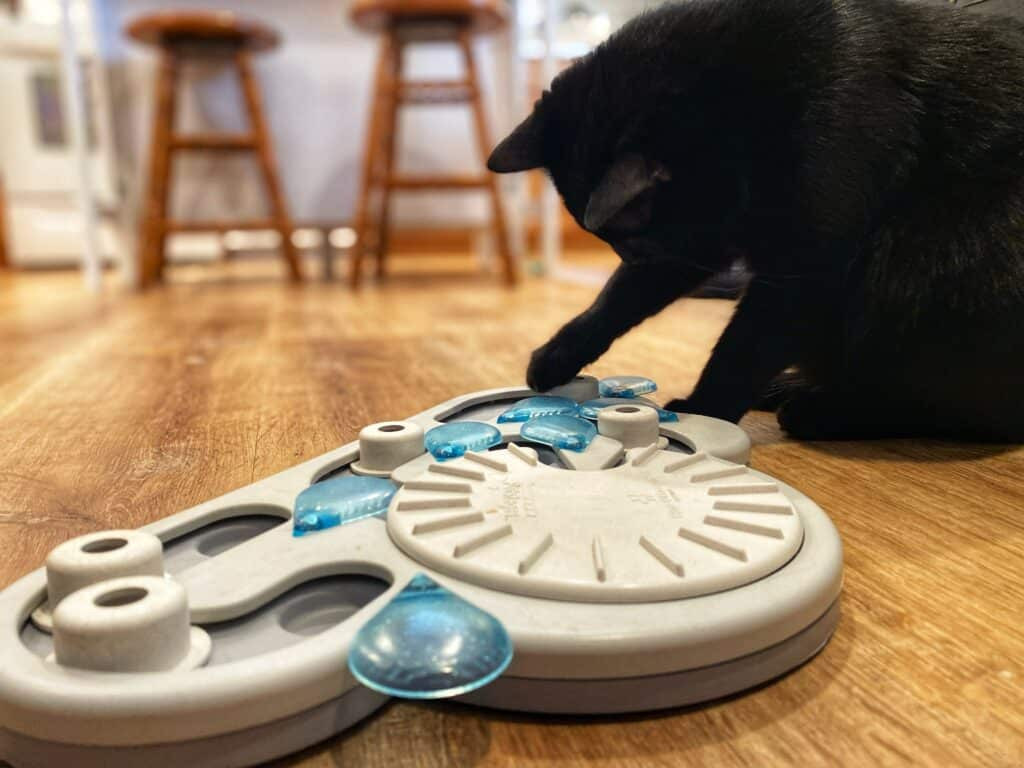 Cat using puzzle Petstages
Cat using puzzle Petstages
Reason 3: Lack of Enticement in the Food
You likely strive to provide your cat with the best possible nutrition. It’s often not about the quality of the food itself, but how enticing it is to your feline foodie.
Kibble is highly processed and often coated with palatants – chemicals designed to make it irresistible to cats. If your cat is accustomed to kibble, other types of food might seem bland or unappealing in comparison. We have a detailed blog post explaining why kibble might not be the healthiest choice for cats if you’re interested in learning more about dry food and feline health.
If your cat has the option of highly palatable kibble alongside other food, they might simply gravitate towards what they find most immediately rewarding, even if it’s not nutritionally superior in the long run. Trying to transition a kibble-addicted cat to a different diet can quickly reveal just how strong this preference can be.
Reason 4: The Food Feels “Too Foreign”
If the above reasons don’t quite fit your situation, your “foodie cat’s” reluctance might stem from unfamiliarity. Food involves more than just taste; smell, texture, and temperature all contribute to a cat’s perception of a meal. Any of these elements can trigger caution if they are outside a cat’s comfort zone.
Cats are creatures of habit and thrive on routine. Stepping outside their established comfort zone, especially regarding food, can be unsettling. And remember, every cat is an individual with their own unique point on this spectrum of food adventurousness.
Keep reading for practical strategies to gently persuade your feline foodie to embrace new and healthy meal options!
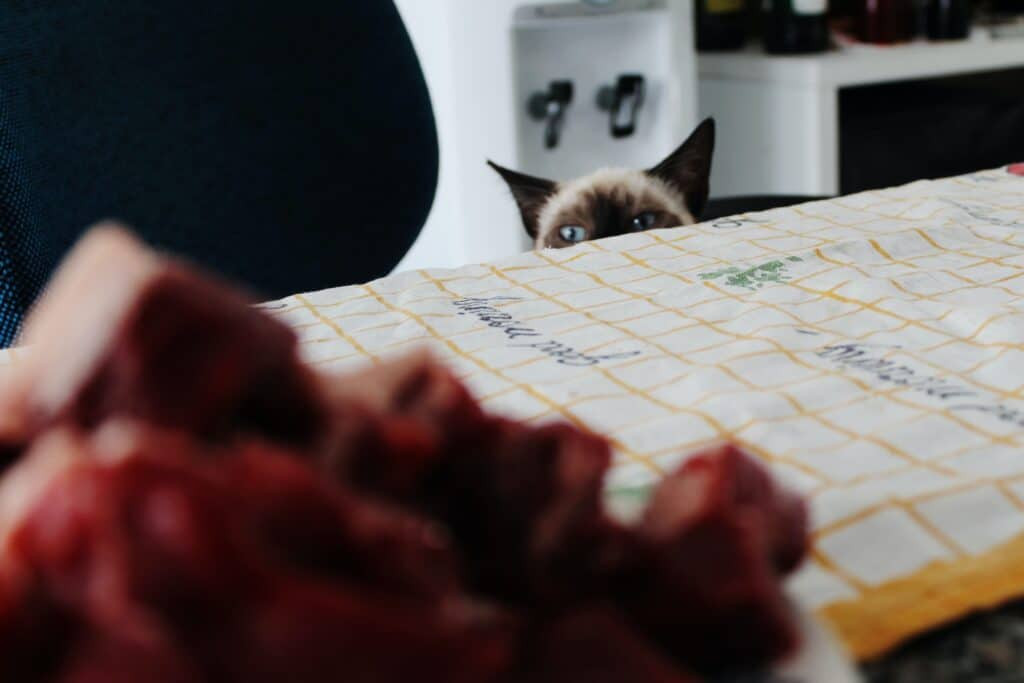 Cat looking at a bowl with raw meet
Cat looking at a bowl with raw meet
Negotiating with Your “Foodie Cat”: Proven Strategies to Encourage Eating
Here are some effective methods to encourage your cat to eat a wider variety of foods. Based on my experience with numerous cats, each with unique preferences, these tips range from simple tweaks to more comprehensive approaches. Experiment to find what works best for your feline companion. Remember, consistency and patience are crucial. Some cats adapt quickly, while others require more time to adjust.
Before diving into the strategies, remember our goal: to help your cat recognize new food as, indeed, food. There are no inherently “picky” cats, just cautious ones. Since cats can’t verbally explain their food hesitations, we need to interpret their behavior and address the sensory aspects of food that might be causing concern – taste, smell, texture, temperature, and presentation.
Strategy 1: Flavor Toppers – The Enticement Experts
This is a straightforward technique: use a flavorful topper to make meals more appealing. We’re essentially reassuring your cat that the food is safe and tasty, not something suspicious!
Utilize your cat’s favorite flavors – treats, tuna, tuna juice, lickable cat treats, the possibilities are vast. Rotating toppers can prevent your cat from becoming fixated on just one.
Be mindful that your cat might become accustomed to toppers and expect them at every meal! (Guilty as charged in my own home! 🙈)
And a specific topper trick I’ve found particularly effective:
Strategy 2: The Magic of Crushed Kibble Dust
This deserves its own spotlight because it’s a surprisingly powerful way to introduce new foods, especially if your cat is primarily a kibble enthusiast.
As mentioned earlier, kibble is often coated with enticing palatants. If your cat is reluctant to try wet food, sprinkle a small amount of crushed kibble on top. This can “trick” them into associating the new food with the familiar and appealing kibble flavor. You can use whole kibble pieces initially, then gradually crush them into smaller crumbs or even dust to further blend the familiar scent and taste.
When transitioning to a new diet, you can slowly reduce the amount of kibble topper over time as your cat becomes more accepting of the new food. We’ll discuss dietary transitions in more detail later.
Strategy 3: Container Cuisine: Freshness Matters
I used to use simple can lids for storing opened cat food in the refrigerator, with mixed success. My cat’s acceptance of the leftovers significantly improved when I switched to storing opened food in sealed containers – I use small glass containers, but BPA-free plastic containers should also work well.
While there isn’t extensive scientific literature specifically on this, many cat owners have observed similar improvements. Storing food in airtight containers seems to help maintain its palatability.
My research (because I always dive deep for answers! 🙈😂) led me to the USDA’s recommendations. They advise that while refrigerating canned food in the can is technically safe, it’s not ideal for flavor retention. Transferring canned food to glass or plastic containers after opening helps preserve its flavor (and appearance, though cats are less concerned with visuals).
Strategy 4: Warming Up to New Flavors
This strategy is closely linked to the container method. Have you ever noticed your cat enthusiastically devour a freshly opened can of food, only to refuse it later or the next day? Yep, been there! 🤦♀️
Research indicates that cats (especially older cats) prefer food served at room temperature or “prey temperature.” One study even suggests that cats prefer food around body temperature, mimicking the warmth of fresh prey in the wild. However, temperatures exceeding 40°C (104°F) might decrease palatability.
You can gently warm your cat’s food by letting it sit at room temperature for a short while before serving. One cat owner shared a tip of placing the food bowl in a pot of warm water to gently heat it to the desired temperature.
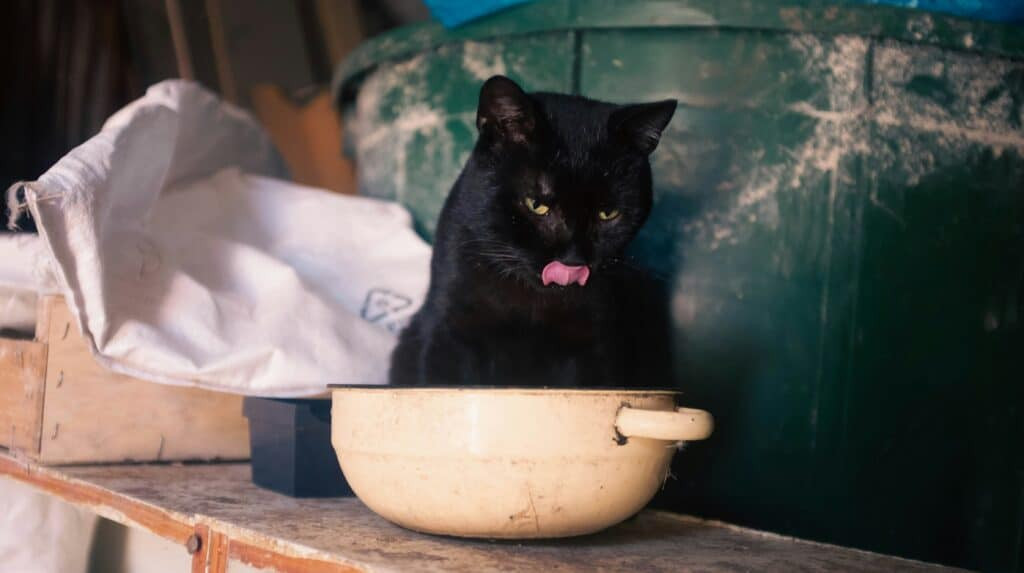 Cat licking his lips. The cat has a big pot in front of him
Cat licking his lips. The cat has a big pot in front of him
Strategy 5: Location, Location, Dining Location!
Recently, while housesitting for friends and their cats, our cat Chumka became hesitant to eat, a common travel-day reaction. Following our usual routine of consistent feeding times, extra enticing food, and affection around meals usually resolves this in a day or two. But this time, there was no improvement. So, I tried a different approach.
I moved his food and water bowls to a different room – the office. It was quieter, less distracting, and contained some familiar scents from our belongings. The result? He resumed his normal eating habits!
If you have multiple pets, separate feeding locations might be beneficial. Or perhaps your cat is sensitive to household noises during mealtimes.
Maybe your cat prefers elevated dining? Young Chumka wasn’t fond of eating on the floor due to “traffic.” Raising his dishes slightly to a less busy spot improved his eating habits. Experiment with different locations to find your foodie cat’s preferred dining ambiance.
Strategy 6: Bowl Brouhaha: The Right Dishware
Experiment with different bowl styles to see if your cat has a preference. While the concept of “whisker fatigue” is debated (and a topic for a future blog post!), some cats do seem to prefer shallow or wider bowls. There’s a vast array of bowl styles and designs available – you’re sure to find something that appeals to both you and your feline foodie.
Strategy 7: Mini Meals, Maximum Meals: Frequent Feeding
In the wild, cats naturally eat multiple small meals throughout the day. Studies suggest that some domestic cats also prefer frequent, smaller meals over two or three larger ones. While you don’t need to drastically overhaul your feeding schedule, there are tools to make frequent feeding easier.
Automatic feeders, especially those with cooling packs to keep food fresh, are invaluable for busy pet parents. You can program them to dispense small portions at intervals throughout the day, ensuring your cat eats on a more natural schedule, even when you’re away.
Featured Product:
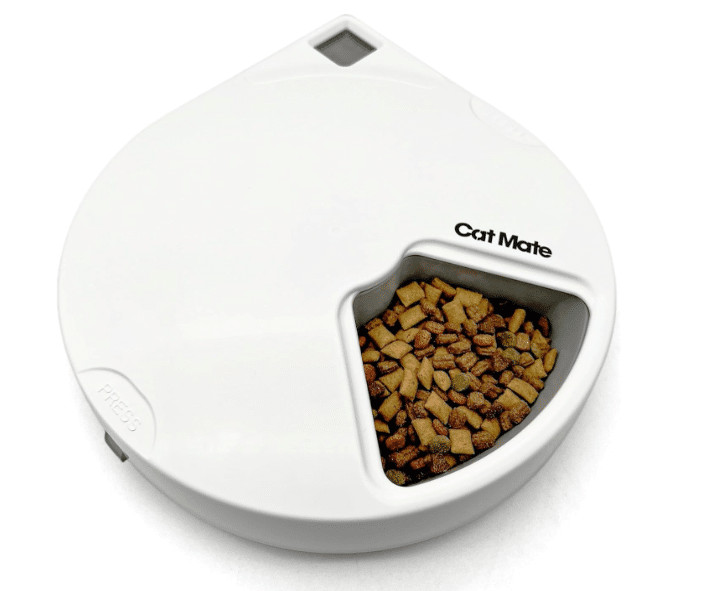
Essential for Busy Cat Parents!
Cat Mate C500 – Automatic Feeder with Ice Packs
This automatic feeder features five food compartments and two ice packs to maintain food freshness. Plus, it’s dishwasher safe!
Strategy 8: Hydration Hint: A Splash of Warm Water
Another simple yet effective trick: adding a few drops of warm water to treats or food can make a significant difference. The moisture seems to enhance the aromas, making the food even more enticing to cats.
Cats have fewer taste buds than dogs or humans. To compensate, they rely heavily on their sense of smell. A cat’s sense of smell is approximately 14 times more acute than ours! They also possess a unique organ called Jacobson’s organ (or vomeronasal organ) in the roof of their mouth, which detects specific chemical cues, even odorless ones.
If a food smells appealing to a cat, they are much more likely to taste it. A little warm water can amplify those enticing aromas.
Strategy 9: Playtime Appetizer: Earn Your Meal
We all know food tastes best when we’re hungry and a bit tired. The same principle applies to cats! One unexpected challenge of having an adventure cat is tiring them out! To truly tire out Chumka, we need either a 4-kilometer walk/hike or 20-30 minutes of intense play… twice a day! 🙈
This strategy works best if you don’t free-feed your cat. Bloat can occur in cats, so avoid playing immediately after they’ve eaten. Also, you want your cat to be genuinely hungry for their meal. Controlling feeding times is difficult with free-feeding.
The goal here is to mimic the natural hunting-eating sequence of wild cats. Playtime simulates the hunt, and then mealtime becomes the rewarding “prey.” This method is consistently effective for me and many cats I’ve worked with.
Chumka’s Playtime Routine:
Disclaimer: Every cat is unique with different needs and abilities. This is just an example of how we play with Chumka.
We play in two sets. I play intensely until he shows signs of tiring (often panting), then we pause for about 5 minutes for him to rest and lower his heart rate. Then, we repeat until he either pants again or loses interest in the toy. While panting in cats can sometimes indicate a problem, in this controlled play environment, it’s simply a sign of vigorous exercise. We always ensure Chumka rests adequately before resuming play. Even our veterinarian has mentioned playing with their cats until they pant as a way to provide sufficient exercise.
 Cat eating fish
Cat eating fish
Introducing New Culinary Delights to Your Foodie Cat
Finally, let’s discuss how to introduce new foods to our cautious feline foodies. This topic warrants its own dedicated article (coming soon!), but it’s essential to touch upon it here.
The key is to introduce new foods gradually and observe your cat’s comfort level. Experiment with different senses – taste, smell, texture. Some cats adapt readily (I even switched Chumka to a raw diet abruptly, though I don’t recommend this!), but most are naturally cautious.
The strategies discussed above become particularly useful when introducing new foods. If your cat is accustomed to kibble and you’re introducing wet food, try topping the wet food with kibble or crunchy treats. Alternatively, start by mixing a tiny amount (a teaspoon or less, depending on your cat’s acceptance) of the new food into their regular kibble. Gradually increase the proportion of new food week by week. The same principle applies when introducing different protein sources or brands.
Final Paws for Thought
I sincerely hope this guide has been helpful in understanding and working with your “foodie cat.” If you know other cat lovers struggling with similar eating challenges, please share this post! Thank you for reading to the end. Give your beloved feline an extra cuddle from me! 😊💛
Please note that some links are affiliate links, and I may earn a small commission on purchases made through them, at no extra cost to you. As always, all opinions and recommendations are my own. Thank you for your support!
References
- Food selection by the domestic cat, an obligate carnivore; J W Bradshaw, D Goodwin, V Legrand-Defrétin, H M Nott
- Taste neophobia: Neural substrates and palatability; Steve Reilly
- Nutritional peculiarities and diet palatability in the cat; G Zaghini, G Biagi
- Aging cats prefer warm food; Ryan Eyre, Melanie Trehiou, Emily Marshall, Laura Carvell-Miller, Annabelle Goyon, Scott McGrane
- Taste preferences and diet palatability in cats; Ahmet Yavuz Pekel
